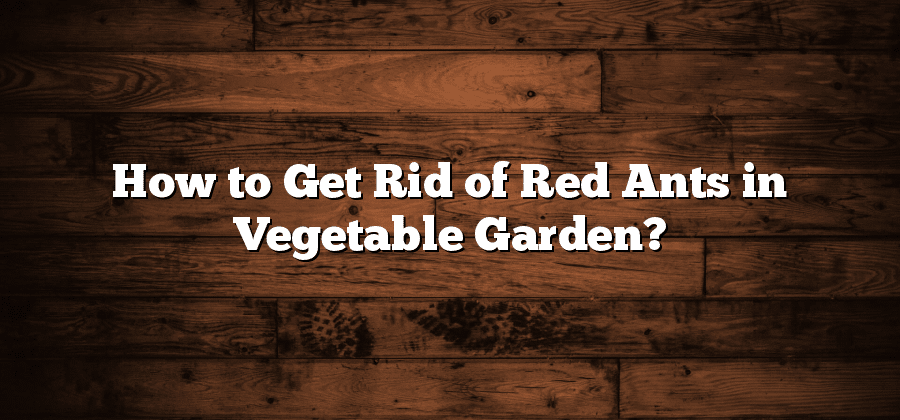Identifying Red Ants in Your Vegetable Garden
It is crucial for gardeners to be able to identify red ants in their vegetable garden in order to effectively combat and prevent infestations. Red ants are small insects, ranging in size from 1/8 to 1/4 inch, and are typically red or reddish-brown in color. They have a distinct thin waist and large mandibles, which they use for digging nests and defending themselves. Red ants are known for their aggressive nature and painful stings, making it important to be able to differentiate them from other harmless ant species commonly found in gardens.
One key characteristic of red ants is their nest-building behavior. They construct large and visible mounds in soil or ground cover, often located near the base of plants or along garden edges. These mounds can reach heights of up to a foot. The presence of these mounds is a strong indicator of red ant activity in the garden. Additionally, red ants are highly active and can be seen moving rapidly around their nests and foraging for food. Their constant movement, especially in large numbers, is another notable behavior that can help gardeners identify red ants.
Understanding the Behavior of Red Ants
Red ants, scientifically known as Solenopsis invicta, are a species that can cause significant damage to your vegetable garden. To effectively manage and prevent infestations, it is crucial to understand their behavior and habits. Red ants have a hierarchical social structure, with a queen at the top, followed by workers, soldiers, and reproductive males. They communicate using pheromones, allowing them to work together efficiently and defend their colonies. Red ants are extremely territorial and aggressive, often attacking intruders or perceived threats. Understanding their behavior will help you develop strategies to control their presence in your vegetable garden effectively.
One crucial aspect of red ant behavior is their foraging patterns. These ants are omnivorous and will search for both sweet and protein-rich food sources. They are particularly attracted to sugary substances, such as nectar, fruit, or even sweet plant sap. Additionally, they actively scavenge for dead insects or other sources of animal protein. Red ants form well-defined foraging trails, following the same routes repeatedly, which can lead to extensive damage in a vegetable garden. By studying their foraging behavior, you can identify the areas in your garden where red ants are most active, enabling you to target your control methods more effectively.
Preventing Red Ant Infestations in Your Vegetable Garden
One of the most effective ways to prevent red ant infestations in your vegetable garden is to maintain a clean and tidy space. Red ants are attracted to food sources, so it is important to remove any leftover food or fallen fruits and vegetables from the garden. Regularly inspect the garden and remove any debris or decaying matter that could serve as a potential food source for the ants. By keeping the garden clean, you can significantly reduce the risk of red ant infestations.
Another method to prevent red ant infestations is to create physical barriers around your vegetable garden. This can be done by installing a perimeter of mulch or gravel around the garden area. Red ants find it difficult to cross these barriers, as the rough texture and uneven surface disrupts their movement. Additionally, you can consider using sticky traps or ant deterrents near the garden to deter ants from entering the area. These physical barriers can be highly effective in preventing red ant infestations and protecting your vegetable garden.
Creating an Unfavorable Environment for Red Ants
In order to keep red ants away from your vegetable garden, it is important to create an unfavorable environment for them. One effective way to do this is by removing any debris or clutter in your garden. Red ants are attracted to areas with piles of leaves, twigs, and other organic matter. By regularly clearing away these items, you can eliminate potential hiding spots and discourage red ants from making your garden their home.
Another important step in creating an unfavorable environment for red ants is to ensure proper drainage in your garden. Red ants are known to prefer moist and damp areas. By improving the drainage in your garden, you can reduce the amount of moisture available to red ants and make your garden a less desirable location for them. This can be achieved by creating trenches or using raised beds to allow excess water to drain away, as well as making sure your plants are not overwatered.
Removing Attractive Food Sources in Your Vegetable Garden
One of the most effective ways to eliminate red ant infestations in your vegetable garden is to remove any attractive food sources that may be enticing them. Red ants are primarily attracted to sugary substances, so be sure to clean up any spilled juices, fruits, or other sweet items that may be laying around. Additionally, make sure to tightly seal and store any opened containers of honey, syrup, or sugar to prevent easy access for red ants.
It is also important to regularly remove any fallen or overripe fruits and vegetables from your garden. These decaying organic materials not only provide a breeding ground for red ants, but they can also attract other pests such as flies and maggots. Be diligent in removing these food sources promptly to discourage red ants from establishing their colonies in your vegetable garden.






